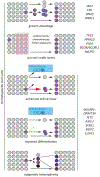Clonal hematopoiesis
- PMID: 28088988
- PMCID: PMC8045769
- DOI: 10.1053/j.seminhematol.2016.10.002
Clonal hematopoiesis
Abstract
Cancer results from multistep pathogenesis, yet the pre-malignant states that precede the development of many hematologic malignancies have been difficult to identify. Recent genomic studies of blood DNA from tens of thousands of people have revealed the presence of remarkably common, age-associated somatic mutations in genes associated with hematologic malignancies. These somatic mutations drive the expansion from a single founding cell to a detectable hematopoietic clone. Owing to the admixed nature of blood that provides a sampling of blood cell production throughout the body, clonal hematopoiesis is a rare view into the biology of pre-malignancy and the direct effects of pre-cancerous lesions on organ dysfunction. Indeed, clonal hematopoiesis is associated not only with increased risk of hematologic malignancy, but also with cardiovascular disease and overall mortality. Here we review rapid advances in the genetic understanding of clonal hematopoiesis and nascent evidence implicating clonal hematopoiesis in malignant and non-malignant age-related disease.
Keywords: Aging; Hematopoietic stem cell; Pre-leukemia.
Copyright © 2017 Elsevier Inc. All rights reserved.
Figures


References
-
- Busque L, Gilliland DG, X-inactivation analysis in the 1990s: promise and potential problems, Leukemia. 12 (1998) 128–135. - PubMed
-
- Limpens J, Stad R, Vos C, de Vlaam C, de Jong D, van Ommen GJ, et al., Lymphoma-associated translocation t(14;18) in blood B cells of normal individuals, Blood. 85 (1995) 2528–2536. - PubMed
-
- Bose S, Deininger M, Gora-Tybor J, Goldman JM, Melo JV, The presence of typical and atypical BCR-ABL fusion genes in leukocytes of normal individuals: biologic significance and implications for the assessment of minimal residual disease, Blood. 92 (1998) 3362–3367. - PubMed
Publication types
MeSH terms
Grants and funding
LinkOut - more resources
Full Text Sources
Other Literature Sources

